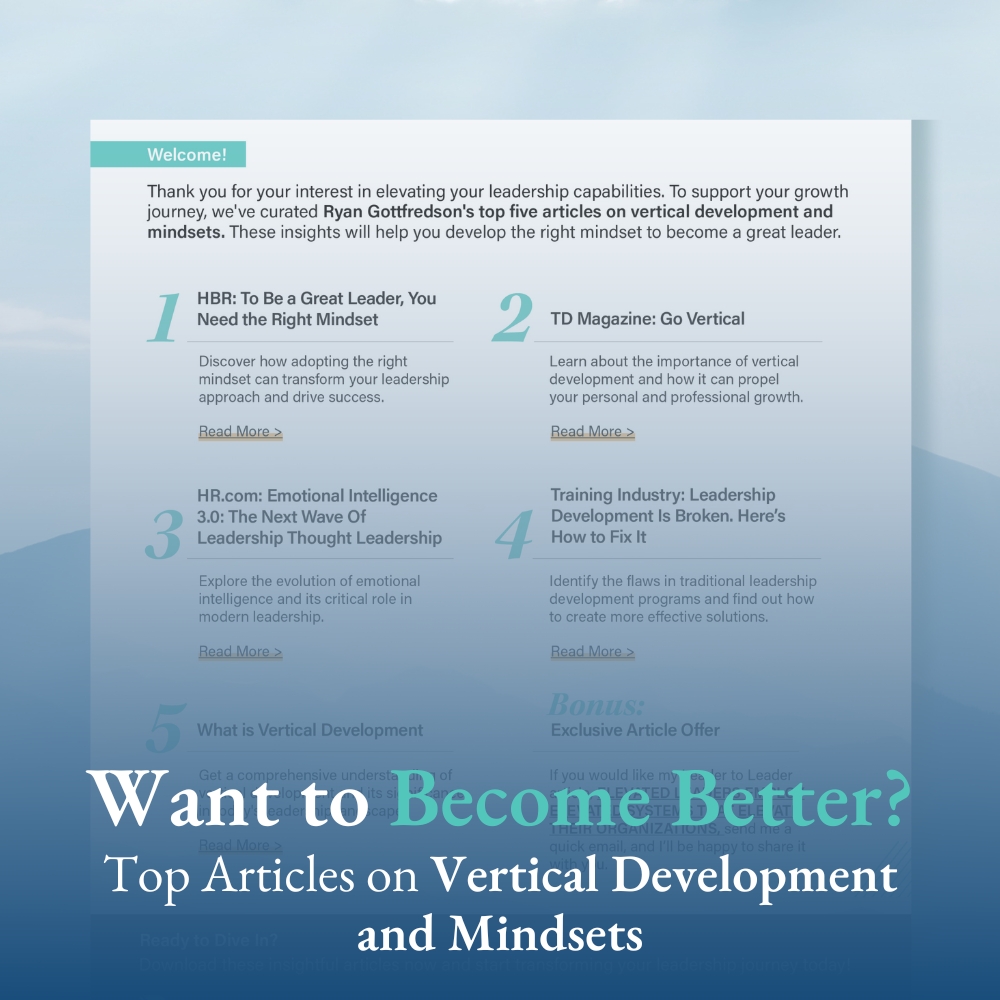If you are unfamiliar with my material, I pull from adult development research, which has found that:
- Adults can develop in adulthood
- There are three different adult developmental stages (I call them Mind 1.0, Mind 2.0, & Mind 3.0).
- The higher the stage, the more effective one operates
- Most adults (64%) never develop in adulthood (they stay in Mind 1.0)
- Most leaders in organizations (85%) operate in Mind 2.0
- The very best and most effective leaders operate in Mind 3.0 (only 8% get here)
In this article, I want to share the four most common differences that I see between Mind 2.0 leaders and Mind 3.0 leaders. They are:

Below, I dive into each of these concepts.
Results-Focused vs Purpose-Focused
When I meet executives or leaders, I will commonly ask them: “How do you measure success in your business?”
Mind 2.0 leaders answer this question by talking about numbers (e.g., revenue, profit, market share, or growth).
For example, one group of leaders answered this question by proudly saying, “Double-digit growth year-over-year.” Unfortunately, this is an organization that operates in the healthcare space. They didn’t even talk about patients or health.
Mind 3.0 leaders answer this question by talking about their impact. They talk about the value they are creating for their key stakeholders (e.g., customers, employees, community, investors).
The difference between Mind 2.0 leaders and Mind 3.0 leaders is that Mind 3.0 leaders possess a clear, inspirational, and stakeholder-centric purpose. This does not mean that they aren’t concerned about the numbers. They just understand that the more they deliver on their purpose and create value for their key stakeholders, they will hit their desired numbers.
Fruit-Focused vs Root-Focused
In a similar vein, Mind 2.0 leaders are fruit-focused. This means that as gardeners, what they are primarily concerned about is the production of fruit or yield. With this focus, they are prone to micromanage and/or provide strong incentives for the production of more fruit.
To continue the gardener analogy, Mind 2.0 leaders try to pull at the tree or the fruit to get them to grow (often faster than what is natural). With Mind 2.0 leaders, there are a lot of arbitrary deadlines.
Mind 3.0 leaders, on the other hand, are root-focused. They understand that in order to get the best growth and the best fruit production, they need to focus on ensuring the health of the plant (particularly the roots). With this focus, they are prone to prioritize culture.
A great example of this is Satya Nadella. Upon being promoted to CEO, he said that “The ‘C’ in CEO stands for Curator of Culture.”
Mind 2.0 leaders tend to undervalue culture and not have it as a key priority.
Short-term Oriented vs Long-term Oriented
Mind 2.0 leaders are internally wired to want to stand out, advance, and get ahead. And, the best way for them to fulfill these needs is to excel at performance or production that generally revolves around arbitrary deadlines. As such Mind 2.0 leaders tend to orient themselves to their nearest deadline or performance criteria. In the process, they lose sight of the longer-term and bigger picture.
Jack Welch, former CEO of GE, is a great example of a Mind 2.0 leader. He excelled at hitting shareholder expectations on a short-term by short-term basis. But, in hindsight, the decisions he made to hit these arbitrary deadlines were only beneficial in the short-term, and disastrous in the long-term.
Mind 3.0 leaders, on the other hand, are wired to contribute, add value, and lift others. They care little about standing out in the short-term, which allows them to make decisions that are optimal for the long-term.
Alan Mulally, former CEO of Ford, is a great example of a Mind 3.0 leader. Upon becoming CEO of Ford, which was set to lose $12.7 billion dollars, he did not emphasize cutting costs as a way to benefit the balance sheet in the short-term. Instead, he had Ford take out the largest loan in history (perhaps the last thing most CEOs would do in that situation). Why? Because he knew that if Ford was ever going to become profitable, they needed to produce cars that people wanted to buy. Thus, he applied this loan to product innovation (commonly, an early cost that is cut).
Leads with Control vs Leads with Context
Mind 2.0 leaders like control. They want to be sure or certain that they will hit their short-term performance benchmarks. This causes them to lead with control.
When leaders lead with control, they make the decisions and pass the execution off to those down the ranks.
Mind 3.0 leaders, being more root-focused, know that they get the highest levels of innovation, creativity, and performance out of their employees when their employees are self-directed. Thus, Mind 3.0 leaders set the context and the parameters and let their employees make the crucial decisions.
If you want to dive more into this topic, I highly recommend No Rules Rules: Netflix and the Culture of Reinvention by Reed Hastings (CEO of Netflix) and Erin Meyer.
Stop and Think
If you are a leader, do you have an accurate read on where you are at between the Mind 2.0 and Mind 3.0 continuums? In my experience, most leaders either:
- Think they are more Mind 3.0 than they really are
- Have a great reason (i.e., excuse) for why they “have to” operate in Mind 2.0
The reality is that we can all become more Mind 3.0.
If you are an HR leader or leadership developer, do you have an accurate read on where your leaders are at between the Mind 2.0 and Mind 3.0 continuums?
Whether you are a leader, HR leader, or leadership developer, if you would like to get a clearer sense of where you/your leaders stand on these continuums, I would love to help. Contact me here.











One Response
This article has been very instructive